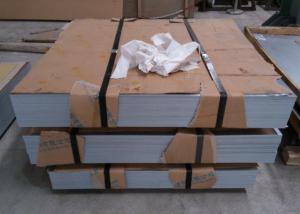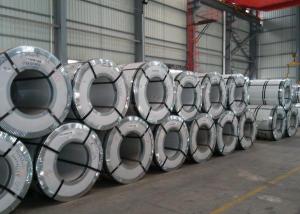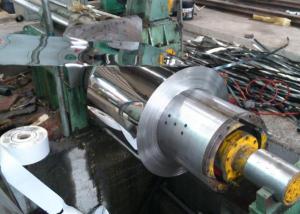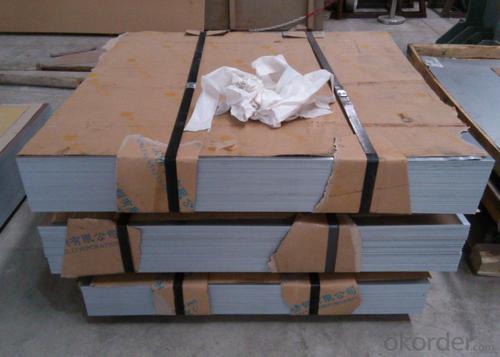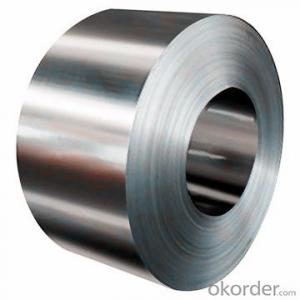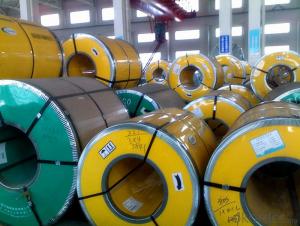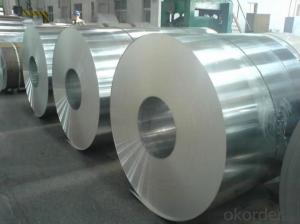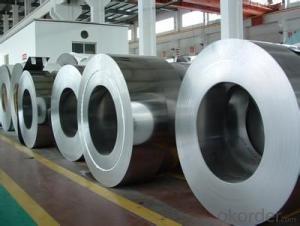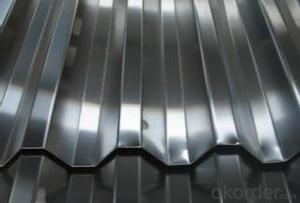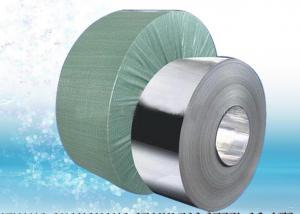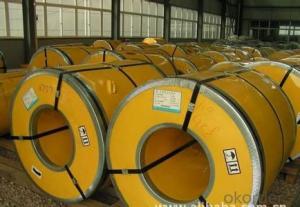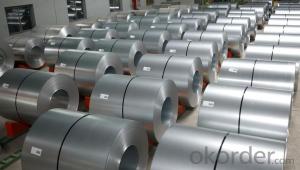High Quality Stainless Steel Coil
- Loading Port:
- China Main Port
- Payment Terms:
- TT or LC
- Min Order Qty:
- 20 Tons m.t.
- Supply Capability:
- 20000 Ton Per Month m.t./month
OKorder Service Pledge
OKorder Financial Service
You Might Also Like
Stainless Steel Coil / Sheet
1.Size of Stainless Steel Coil: Thickness: 0.3mm ~~ 6mm, Width: 650mm ~~ 2100mm, Length: to be customized.
2.Material of Stainless Steel Coil:SUS201,202,301,304,304L,316,316L ,321 etc.
3.Standard of Stainless Steel Coil:AISI,JIS,GB,DIN
4.Finish of Stainless Steel Coil:Black, No.1, 2B, 2D, BA, NO.3, NO.4, SB, NO.8, HL
5.Testing of Stainless Steel Coil:Each heat number and batch must be tested for both chemical and mechanical properties
Stainless Steel Coil / Sheet | |
Standard | JIS, AISI, ASTM, GB, DIN, EN |
Property | Stainless steel coil, Stainless steel sheet, Stainless steel plate, stainless steel |
Length | 1-12m |
Quality | prime |
Manufacturing Process | factory direct sale |
Surface Treatment | Black, No.1, 2B, 2D, BA, NO.3, NO.4, SB, NO.8, HL |
Main Grade | 201,201,301,302,303,304,321,316,316L,309,310,309H, 310S,431,430,420,430F |
MOQ | 20 ton |
Trade Term | FOB China mainport |
Payment term | T/T or L/C |
Price | negotiable |
Packing | Export packing |
Dilvery time | 20days or depend on order quantity |
Container | The capacity for a 20" container:20-24tons |



- Q: Are stainless steel strips suitable for medical applications?
- Stainless steel strips are indeed appropriate for medical purposes. They are highly favored in the medical field because of their exceptional resistance to corrosion, durability, and ease of sterilization. The notable levels of chromium found in stainless steel strips make them extremely resistant to corrosion, a crucial factor in maintaining a sterile environment for medical uses. Furthermore, stainless steel strips can endure the high temperatures and pressures typically encountered during the sterilization process. The material is also robust and long-lasting, enabling it to withstand the demands of medical procedures and equipment. In addition, stainless steel is biocompatible, ensuring that it does not react with bodily tissues or fluids, thus making it safe for implantable medical devices like surgical instruments, orthopedic implants, and prosthetics. All in all, stainless steel strips are a dependable and extensively utilized material in various medical applications due to their cleanliness, functionality, and compatibility with the human body.
- Q: Are stainless steel strips suitable for automotive fuel systems?
- Yes, stainless steel strips are suitable for automotive fuel systems. Stainless steel is highly resistant to corrosion, making it an ideal material for components in fuel systems that are constantly exposed to fuel and moisture. Its durability and strength also ensure the longevity of the fuel system components.
- Q: What is the thickness range of stainless steel strips?
- The thickness of stainless steel strips can vary depending on the specific application and requirements, encompassing a range. In general, these strips are offered in thicknesses between 0.02 millimeters and 5 millimeters. Nevertheless, it is crucial to acknowledge that tailored thicknesses can be produced to cater to individual needs. The choice of the suitable thickness hinges on factors including the intended purpose, structural necessities, and desired visual appeal.
- Q: What are the common uses of stainless steel strips in the pharmaceutical packaging industry?
- Stainless steel strips have several common uses in the pharmaceutical packaging industry. One of the primary uses is in the production of packaging containers and components. Stainless steel strips are used to manufacture various types of containers such as vials, ampoules, and syringes. These containers need to be made from a material that is corrosion-resistant, durable, and can maintain the sterility of the pharmaceutical products. Stainless steel, with its high resistance to corrosion and ability to withstand high temperatures, makes it an ideal choice for ensuring the safety and integrity of the packaged drugs. In addition to containers, stainless steel strips are also utilized in the production of packaging components such as lids, caps, and closures. These components play a crucial role in maintaining the quality and freshness of pharmaceutical products. Stainless steel's resistance to rust and its ability to provide an airtight seal make it suitable for ensuring the integrity of the packaged medications. Furthermore, stainless steel strips are utilized in the construction of pharmaceutical machinery and equipment. Pharmaceutical manufacturing processes often involve the use of heavy machinery that requires durable and corrosion-resistant materials. Stainless steel strips are commonly used in the fabrication of machine parts, conveyor systems, and packaging equipment to ensure their longevity and reliability. Another common use of stainless steel strips in the pharmaceutical packaging industry is for labeling and identification purposes. Stainless steel strips can be engraved or etched with important information such as batch numbers, expiration dates, and drug identification codes. This ensures that the pharmaceutical products can be accurately tracked, traced, and identified throughout the packaging and distribution process. Overall, stainless steel strips offer numerous benefits in the pharmaceutical packaging industry. Their corrosion resistance, durability, and ability to maintain sterility make them an essential material for manufacturing containers, components, machinery, and labeling in the pharmaceutical packaging sector.
- Q: Are 111 stainless steel strips susceptible to stress corrosion cracking?
- Stress corrosion cracking (SCC) can affect stainless steel strips with the crystallographic orientation of 111. However, it is crucial to consider that SCC is influenced by various factors, including the specific environment, applied stress levels, and the microstructure and composition of the material. Although 111-oriented stainless steel strips may display a higher resistance to SCC compared to other crystallographic orientations, they are not entirely immune to this form of corrosion. SCC occurs when a combination of tensile stress and a corrosive environment is present, resulting in material cracking. The susceptibility of 111 stainless steel strips to SCC can be affected by the presence of certain corrosive agents, such as chloride ions or hydrogen sulfide. These agents have the ability to infiltrate the passive oxide layer on the stainless steel surface, initiating and propagating cracks under applied stress. To minimize the risk of stress corrosion cracking in stainless steel strips, several precautions can be taken. These include selecting a stainless steel grade with enhanced resistance to SCC, avoiding exposure to corrosive environments, controlling applied stress levels, and implementing appropriate surface treatments or coatings. Additionally, regular inspection and maintenance procedures can aid in the detection of potential SCC signs and prevent further damage. In conclusion, the resistance of 111 stainless steel strips to stress corrosion cracking is not absolute and depends on multiple factors. Employing appropriate preventive measures and understanding the specific environment in which the material is utilized are crucial for reducing the risk of SCC.
- Q: What is the difference between cold rolled and hot rolled stainless steel strips?
- Cold rolled and hot rolled stainless steel strips differ in their manufacturing processes and resulting properties. Cold rolled stainless steel strips are produced by passing the stainless steel through a series of rollers at room temperature. This process results in a thinner and more precise strip with a smooth and shiny surface finish. Cold rolling also increases the strength and hardness of the stainless steel, making it suitable for applications that require high strength and a polished appearance. Additionally, cold rolled stainless steel strips have better dimensional accuracy and straightness compared to their hot rolled counterparts. On the other hand, hot rolled stainless steel strips are manufactured by heating the stainless steel slab or billet to a high temperature and then rolling it through a series of rolling mills. This process produces a thicker and less precise strip with a rough and scaled surface finish. Hot rolling is preferred for applications that do not require a high level of precision or a polished appearance, such as structural applications or manufacturing processes that involve further shaping or forming of the stainless steel strip. In terms of properties, cold rolled stainless steel strips have higher tensile strength and yield strength compared to hot rolled strips. They also exhibit better corrosion resistance, as the cold rolling process helps to refine the microstructure of the stainless steel, reducing the presence of defects and impurities. However, hot rolled stainless steel strips have higher ductility and are more easily formable due to their higher temperature processing. Overall, the choice between cold rolled and hot rolled stainless steel strips depends on the specific application requirements, such as the desired surface finish, dimensional accuracy, strength, and formability.
- Q: Can stainless steel strips be used in cryogenic applications?
- Yes, stainless steel strips can be used in cryogenic applications. Stainless steel is known for its excellent resistance to extreme temperatures, including low temperatures found in cryogenic environments. It retains its strength and integrity even at very low temperatures, making it suitable for use in cryogenic applications. Additionally, stainless steel has good corrosion resistance, which is essential in cryogenic environments where moisture and other corrosive elements may be present. Overall, stainless steel strips are a reliable and durable choice for use in cryogenic applications.
- Q: What are the common uses of stainless steel strips in the pulp and paper industry?
- The utilization of stainless steel strips is widespread in the pulp and paper industry owing to their remarkable characteristics and adaptability. Below are several typical applications of stainless steel strips in this sector: 1. Screens and filters: In various stages of the papermaking process, screens and filters made from stainless steel strips are employed. These aids in eliminating impurities and undesired particles from the pulp, guaranteeing the production of a top-notch final product. 2. Doctor blades: The manufacture of doctor blades also relies on the use of stainless steel strips. Doctor blades are critical components of paper machines as they remove excess water and chemicals from the paper during the drying process. The longevity and efficient performance of doctor blades are ensured by the corrosion resistance and durability of stainless steel. 3. Rollers and shafts: The creation of rollers and shafts utilized in paper machines frequently involves stainless steel strips. These rollers and shafts have a vital role in guiding the paper through different production stages, including drying, coating, and printing. Stainless steel's high strength and resistance to wear make it an excellent choice for these purposes. 4. Wires and mesh: Extensive usage of stainless steel strips can be observed in the production of wires and mesh used in paper machines. These wires and mesh aid in the formation and transportation of paper fibers, ensuring proper drainage and consistency. Stainless steel's corrosion resistance guarantees the durability and good condition of the wires and mesh, even when exposed to chemicals and moisture. 5. Pipelines and fittings: The construction of pipelines and fittings used for the transportation of fluids and chemicals within the pulp and paper industry also involves the application of stainless steel strips. Stainless steel's resistance to corrosion and high temperatures makes it a dependable choice for these applications, ensuring the safe and efficient flow of liquids throughout the production process. In conclusion, the durability, corrosion resistance, and versatility of stainless steel strips render them indispensable in the pulp and paper industry. From screens and filters to doctor blades and rollers, stainless steel strips play a pivotal role in ensuring smooth operations and the production of high-quality paper.
- Q: Can stainless steel strips be used in marine vessel construction?
- Yes, stainless steel strips can be used in marine vessel construction. Stainless steel is highly resistant to corrosion, making it an excellent choice for marine applications. It is able to withstand exposure to saltwater, which is highly corrosive, without rusting or deteriorating. Stainless steel strips can be used in various areas of a marine vessel, including the hull, deck, fittings, and equipment. Its durability, strength, and resistance to corrosion make it a reliable material for constructing marine vessels that can withstand the harsh conditions of the ocean.
- Q: How does the price of stainless steel strips compare to other materials?
- The price of stainless steel strips can vary depending on the specific grade and size of the strip, as well as current market conditions. However, in general, stainless steel strips tend to be more expensive compared to other materials. This is primarily due to the higher cost of production and the unique properties of stainless steel. Stainless steel is known for its exceptional corrosion resistance, durability, and strength. It is also highly resistant to heat and physical damage, making it suitable for a wide range of applications in various industries. These superior properties contribute to the higher price of stainless steel strips compared to other materials. In contrast, materials like carbon steel or aluminum are generally more affordable. Carbon steel strips are widely used due to their lower production costs and satisfactory strength properties. Aluminum strips, on the other hand, are lightweight and have good corrosion resistance, but they are less strong and durable than stainless steel. When considering the price of stainless steel strips, it is important to evaluate the specific requirements of the intended application. While stainless steel may be more expensive upfront, its long-term benefits, such as extended lifespan and reduced maintenance costs, can make it a more cost-effective choice in many cases. Ultimately, the price of stainless steel strips is influenced by numerous factors, including market demand, availability of raw materials, and manufacturing processes. It is advisable to consult with suppliers or industry experts to obtain accurate and up-to-date pricing information for stainless steel strips and compare it with other materials to make an informed decision.
1. Manufacturer Overview
| Location | Zhejiang,China |
| Year Established | 2010 |
| Annual Output Value | Above US$16Million |
| Main Markets | Japan, South America |
| Company Certifications | ISO9001:2000; |
2. Manufacturer Certificates
| a) Certification Name | |
| Range | |
| Reference | |
| Validity Period |
3. Manufacturer Capability
| a) Trade Capacity | |
| Nearest Port | Shanghai |
| Export Percentage | 60% |
| No.of Employees in Trade Department | 50 People |
| Language Spoken: | English;Chinese; Japanese |
| b) Factory Information | |
| Factory Size: | Above 80,000 square meters |
| No. of Production Lines | Above 8 |
| Contract Manufacturing | OEM Service Offered;Design Service Offered |
| Product Price Range | Average |
Send your message to us
High Quality Stainless Steel Coil
- Loading Port:
- China Main Port
- Payment Terms:
- TT or LC
- Min Order Qty:
- 20 Tons m.t.
- Supply Capability:
- 20000 Ton Per Month m.t./month
OKorder Service Pledge
OKorder Financial Service
Similar products
Hot products
Hot Searches
Related keywords
